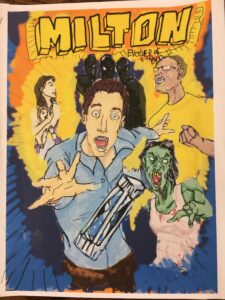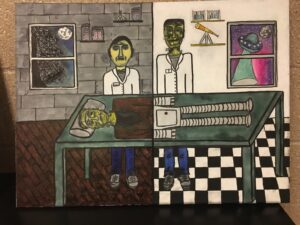
Nana Kodjo Acquah – Asare’s short graphic novel Milton (illustrated by Smite, lettered by Cleopatra) explores the themes of scientific overreach, self-serving ambition, and faceless corporate greed. The narrative structure draws on the conventions of the comic book genre, beginning in medias res before hinting at the title character’s “origin story” in a series of flashbacks. This choice allows Acquah – Asare to tell a very complex story in a relatively short space.
The plot itself derives in large part from Frankenstein, Oryx and Crake, and contemporary zombie mythology (particularly 28 Days Later). Yet Acquah – Asare’s attention to detail reminds us that this is an homage, not a derivative: the laboratory in particular includes a portrait of Frankenstein’s Creature hung proudly, like a family member’s, on the wall, while a book titled Adam and Eve recalls Milton’s namesake.
It’s interesting that the title character takes his name from the author of Paradise Lost rather than from a character in any of the works in the long tradition of mad-scientist stories. Perhaps this choice indicates that the author is the maddest scientist of all.
Is Milton being kept artificially alive in the last frame? We will have to wait for the next issue to find out…
kodjo


















